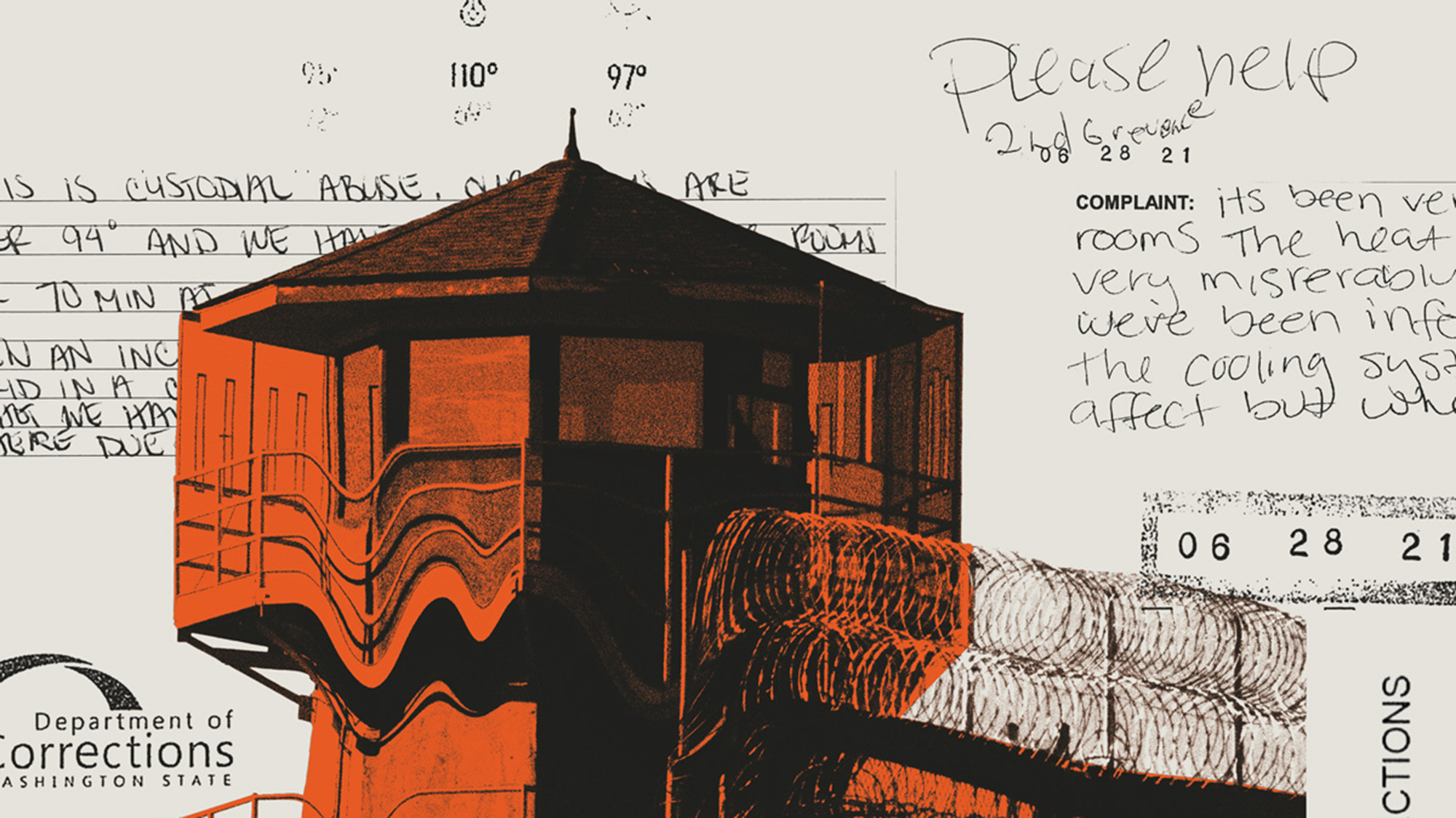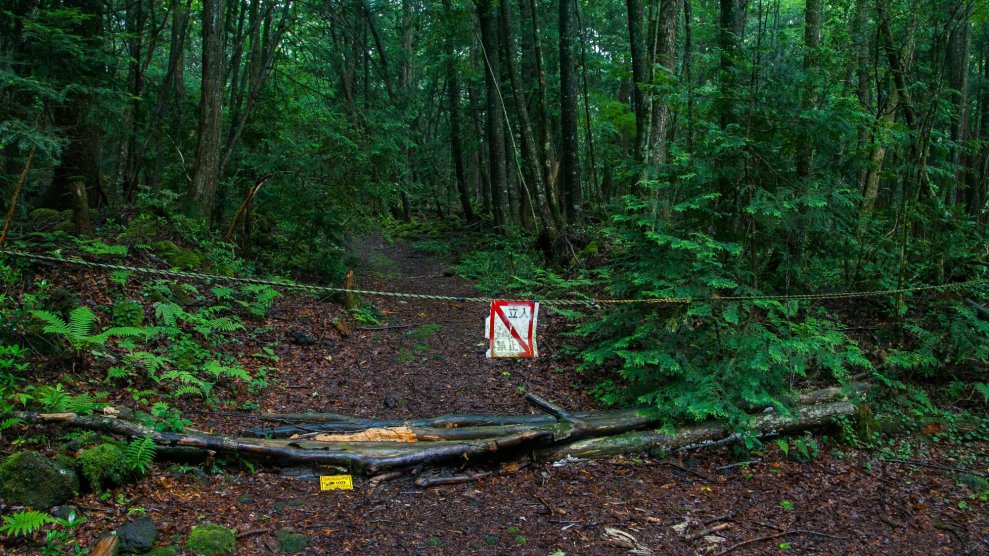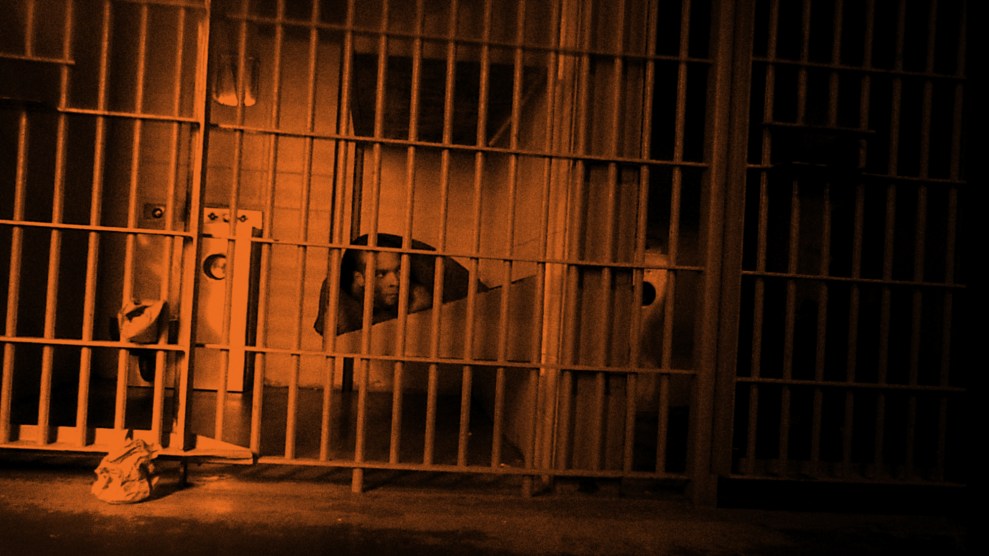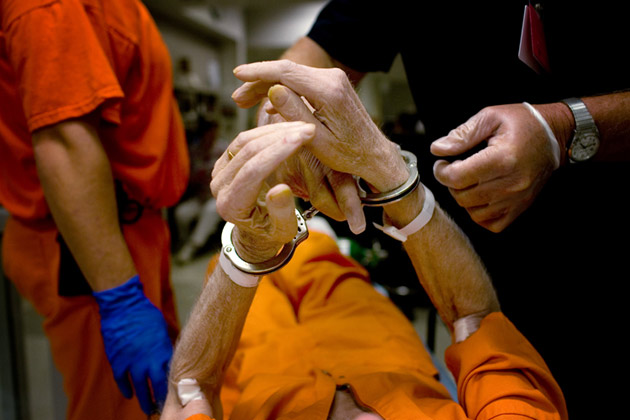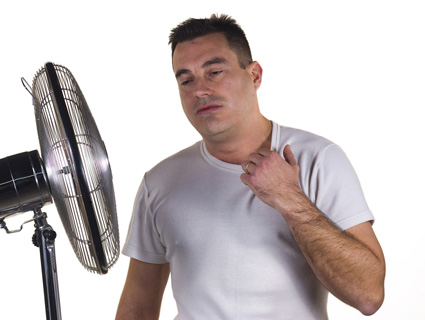This story was originally published by High Country News and is reproduced here as part of the Climate Desk collaboration.
Late last June, farmers in Walla Walla, Washington, noticed something odd happening to their onions. Walla Walla, an oasis in the middle of the state’s high desert, is bursting with vineyards, wheat fields and acres of the city’s eponymous sweet onions. As temperatures climbed above 100 degrees Fahrenheit, then above 110 degrees, the oversized onions began to burn, pale blisters forming underneath their papery skins. When the temperature reached 116, the onions started cooking, their flesh dissolving into mush.
Four miles away is the Washington State Penitentiary. It’s one of the country’s oldest prisons, established in the 1880s, before Washington achieved statehood. In June 2021, over 2,000 people were incarcerated in its large concrete buildings. In the Hole—the name incarcerated people use for the solitary confinement unit—the air conditioning had stopped working. Dozens of people spent 23 hours a day locked in small concrete and metal cells, even as temperatures continued to soar.
Washington isn’t known for extreme heat, but far above the fields and prison, two air pressure systems had collided, creating a massive heat dome: a cap of warm air that sealed in the heat and blocked the flow of cool marine breezes from the Pacific. The resulting weeklong heat wave brought some of the hottest temperatures that the state has ever experienced.
State officials and media had begun to sound the alarm the week before. “‘Heat dome’ may push Western Washington temperatures into record-breaking territory,” the Seattle Times wrote on Sunday, June 20, the first day of summer. Two days later, the National Weather Service started issuing excessive heat watches and warnings for the upcoming weekend covering almost all of Oregon and Washington. Seattle and King County offered emergency guidance: “Spend more time in air-conditioned places. If you don’t have air conditioning, consider visiting a mall, movie theater or other cool public places.” Around the state, people began stockpiling ice and ice cream, and fans and air conditioners became harder and harder to find.
That was when Darrell Cook started to worry.

Cook, who is incarcerated at the Twin Rivers Unit inside the Monroe Correctional Complex, the state’s second-largest prison, had been following local news broadcasts about the impending heat wave on TV. Cook has diabetes, which puts him at risk for heat-related illness, such as heat stroke. He was concerned about the other men in his unit, too.
The combination of extreme heat and incarceration has been dubbed an “overlooked crisis.” Incarcerated people are vulnerable to heat for many reasons: Nationwide, almost 20 percent are over the age of 51, and underlying medical conditions like obesity, hypertension and asthma are common. By definition, people in prison are confined to a space they have no control over. And many suffer from mental health issues and take psychotropic medications, which can reduce the body’s ability to regulate temperature.
Summers at the Twin Rivers Unit, 30 miles east of Seattle, have always been miserable, Cook said in a phone interview. The facility lacks air conditioning, and large glass skylights in a common area create a greenhouse effect, while the unit’s open showers drive up the humidity. Cook compared the resulting muggy, grimy atmosphere to a petri dish. On the news, broadcasters emphasized how dangerous the heat would be for anyone stuck in buildings without air conditioning, especially elderly people with medical conditions. That described a good portion of the population at Twin Rivers, Cook thought.
High Country News obtained 95 grievances submitted to officials by people incarcerated in 10 of Washington’s 12 state prisons during the unprecedented heat wave. These reports, acquired via a public records request, reveal extreme conditions—and the state prison system’s failure to establish coherent and actionable heat plans that would keep the people they are responsible for safe. The incarcerated people interviewed for this piece recalled dangerous indoor temperatures that lasted for days, causing heat exhaustion and rising panic, and prison staff resorting to making up rules that lacked consistency. Many heat provisions were implemented ad hoc, after incarcerated people complained or begged for relief.
The overall picture shows a state prison system floundering under the heat. Interviews with officials, legal and policy experts and incarcerated people show that not only has the Washington State Department of Corrections failed to address many of the problems that were exposed, it is also failing to prepare for an increasingly hot future.

The Cascade Mountains stretch like a spine up the state of Washington. Eighty percent of the state’s nearly 8 million residents live in western Washington, which is buffered by the ocean and much more temperate than eastern Washington. Nine of the 12 prisons run by the Department of Corrections are located there. According to Jacque Coe, the department’s former communications director, all of the units at the three state prisons east of the Cascades are air-conditioned. In contrast, only a handful of those on the west side are.
“In the event that the temperature exceeds the comfort zone”—66 to 80 degrees Fahrenheit in the summer, a standard from the American Correctional Association—“for a prolonged period of time, alternate methods of heating and cooling will be put in place as a temporary measure to keep the unit within acceptable guidelines,” Sean Murphy, the deputy secretary of the Department of Corrections, wrote in response to legislative officials and concerned family members before the heat wave.
But only one Washington prison had a plan in place before the heat wave hit, according to documents released by the Department of Corrections in response to a public records request. One other prison released heat provisions two days into it. (Prison staff receive yearly training on recognizing the symptoms of heat exposure, according to the Department of Corrections.)
That Friday, June 25, before the heat wave began, Jeannie Miller, assistant secretary of the Administrative Operations Division, sent an email to all Department of Corrections staff. The three-page memo noted that the upcoming extreme weather meant that there would be “little to no relief from the heat overnight.” It warned of the high risk of heat-related impacts, especially for heat-sensitive people without cooling and adequate hydration, and included tips from the Washington Department of Health on how to stay cool—using fans to blow hot air out, staying in air-conditioned spaces, and covering windows and using awnings, which can reduce the heat entering a building by as much as 80 percent.

The first day of the heat wave, Saturday, June 26, was hot with barely a whisper of a breeze. Amtrak slowed down trains to avoid derailments due to heat-warped tracks. Seattle broke its all-time June temperature record—97 degrees—with a new record of 102.
The Monroe Correctional Complex, where Cook is incarcerated, implemented an Incident Action Plan, mandating cooling stations in some facilities and misting stations and sprinklers outside. People were permitted to cover their windows and wear shorts and sandals. It was the only state prison to put an emergency heat plan into place.
On the other side of the Cascades, an incarcerated man with asthma at the Airway Heights Corrections Center near Spokane was struggling with the heat. Unable to stand it any longer, he filed an emergency grievance. “It is very hard to breathe with the extreme heat and humidity,” he wrote.
The grievance process, established by federal law in 1996, is supposed to give those incarcerated a way to document complaints and resolve them internally. In theory, after a grievance form is received, a resolution specialist has up to 10 working days to respond and try to resolve the issue informally—or an hour, if it’s an emergency grievance.
Six hours later, with the heat still rising, the man wrote another grievance, his handwriting larger and more urgent, spilling over the form’s small black lines. “Heat is too great and causing me trouble breathing,” he wrote, requesting that fans be put in the dayroom. This time, he submitted the grievance to the resolution box in the unit. Suzanne Cook, Darrell’s wife and a criminal justice advocate, said that, in practice, the grievance process is a bit of a joke.
The incarcerated individuals interviewed for this piece agreed; few expected their grievances to be addressed fairly or timely, and some feared retribution by prison staff for even submitting them. “They’re only a snapshot of what is happening inside,” Suzanne Cook said. Christopher Blackwell, an incarcerated writer in Washington, echoed this sentiment in a recent article, calling the prison grievance process “broken and unjust.”
At the top of the man with asthma’s first grievance is a note implying that a sergeant read it seven hours after he wrote it; the official response suggested he buy a fan.

Sunday, June 27, was even hotter than Saturday. Around Seattle, thousands of Puget Sound Energy and Seattle City Light customers reported outages as people cranked up their air conditioners. At least one Safeway closed its freezer aisle due to the heat.
Inside Washington’s prisons, the trickle of grievances became a small stream. Officers at the Twin Rivers Unit started rationing ice and ice water and retreating to their air-conditioned offices, while temperatures in some of the cells reached 100 degrees, according to grievances. Darrell Cook saw signs of heat exhaustion mounting around him. “They were calling medical emergencies literally two, three (times) an hour,” he said.
At 1:30 p.m., Cook found James Ruzicka, facedown and shirtless on Ruzicka’s bunk, the sun glaring down on him through an uncovered window. Ruzicka, who has a chronic lung disease, had passed out from the heat. “I was working in the pot tanks,” a part of the prison kitchen, he recalled in a phone interview. “It was like an oven.” He was put in a trauma room to cool down and then sent back to his cell, where Cook brought him water and managed to cover his window.
To the east, behind the walls of the Washington State Penitentiary in Walla Walla, several people begged to be taken out of the Hole, where conditions were stifling. “It is out of line how hot it is in our cells,” reads one grievance. “It’s too hot to live in these conditions, please help!!” another person scrawled in large letters.
Bradley Cooper, 48, recalled lying on the bed, which takes up much of the room, with just his boxers on, sweat dripping onto the hot metal bed frame. “It’s like sitting in a sauna, not being able to move, not being able to go anywhere,” he said in an interview. “It’s miserable.”
“Is the heat in your home climbing to unreasonable levels?” the Washington Emergency Management Division tweeted that afternoon. “Don’t risk it. Find a cooling center, a grocery store, a shopping mall.”
With no air conditioning, no fan, and the sun streaming through his curtainless window, Shane Brewer, a 36-year-old man incarcerated at the Washington Correctional Complex on the Olympic Peninsula, desperately sought some relief. From his bunk, he watched the heat spiral off the metal bars covering the windows. People were overheating in the cells around him, some breaking out in ugly red splotches like chicken pox—heat rash.
“We know policy no obstructed windows,” he wrote in an emergency grievance, squeezing the words together to fit them in the small complaint box. “How about a policy when it is 103° with no ventilation and the only way to breathe is to lay on the ground?”
After measuring the cells with a temperature gun, a sergeant decided to allow window coverings. (The Department of Corrections said it had no knowledge of this, and that it was not part of any formal guidance.) But without curtain rods or hooks, people had to be creative, Brewer wrote in an email. Some poked plastic spoons through blankets and jammed them into the window seals, hanging the blanket loosely over the window.
Brewer wedged four 4-ounce Crawford body lotion bottles as tightly as possible between the edges of the blanket and the metal grills, taking care not to touch the piping hot metal with his bare hands. This stretched the blanket more tightly across the window, he explained.
Nights were the worst; sleep was almost impossible, Brewer said. He would lie down on the bare concrete floor and cover himself with a wet towel, hoping for a few hours of rest.
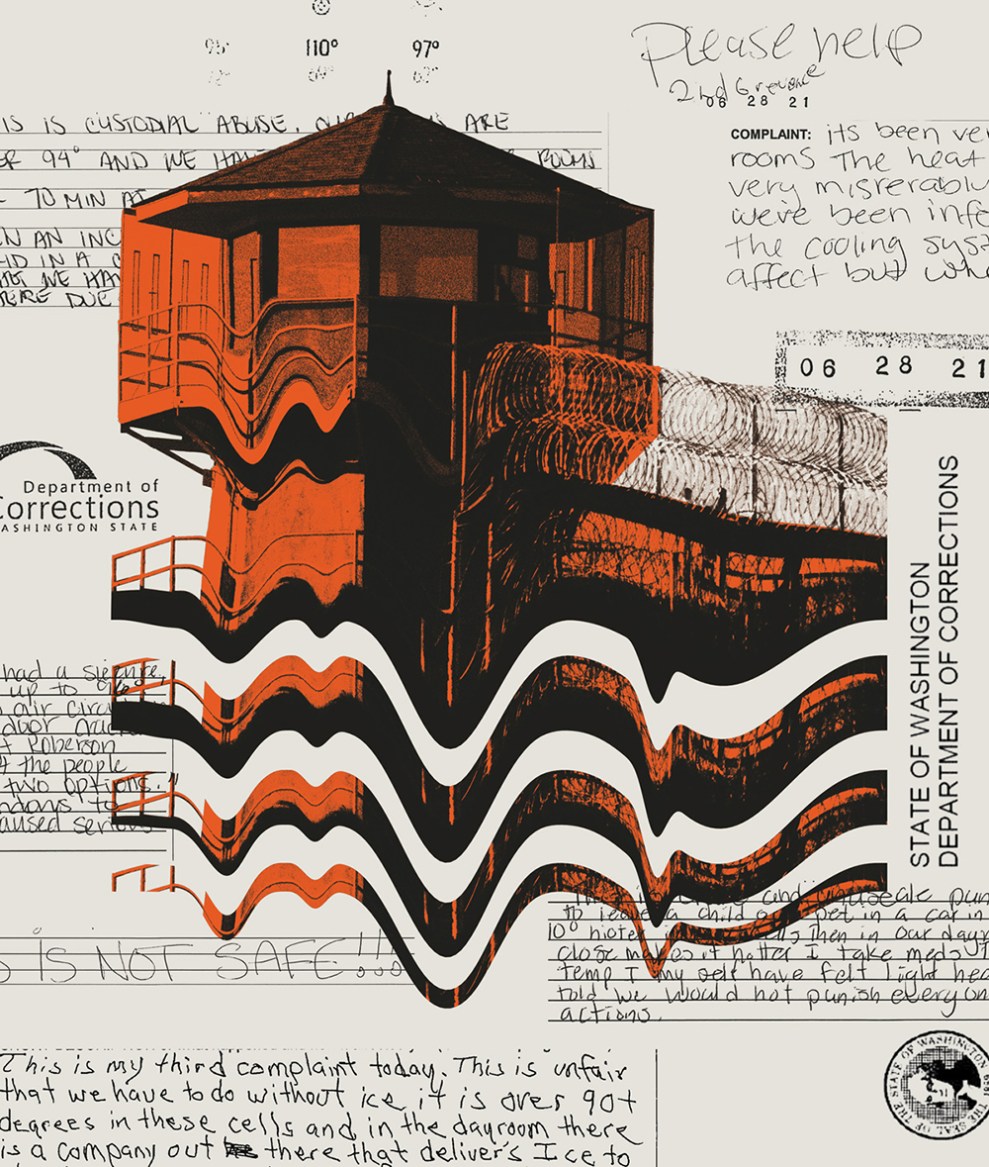
At 2 a.m. on Monday, June 28, the temperature in a cell at the Washington Corrections Center for Women measured 94 degrees Fahrenheit, according to an emergency grievance submitted later that day. In a particularly alarming trend, climate change is causing average nighttime temperatures to warm even faster than average daytime temperatures, said Deepti Singh, a climate scientist at Washington State University who studies extreme weather events. This is especially dangerous because it limits the body’s ability to cool down, significantly increasing the risk of heat-related illnesses.
As the day got hotter, lanes on Interstate 5 in north Seattle buckled from the heat. A reading of 108 degrees was measured at the Seattle-Tacoma airport, the hottest temperature since record-keeping began there in 1870.
The Department of Corrections sent a one-page email to all state prisons with examples of how some facilities were trying to mitigate the extreme heat. The Office of the Corrections Ombuds, a watchdog agency set up to oversee the department in 2018, sent a team to Monroe. The agency had been receiving heat-related complaints from across the state via a hotline for incarcerated individuals, with the majority coming from Monroe, Sonja Hallum, the interim director of the Ombuds, said.
Cook recalled that the visit created a flourish of activity in his unit; suddenly, maintenance crews were all over, installing water misters indoors and out, and putting ice-water coolers in the dayrooms. When they arrived, the cells registered around 95 degrees; the temperature of the glass skylights above the common areas was 128 degrees. Vents were sucking hot air from the roof and pushing it inside; some incarcerated people had resorted to covering them completely.
The unit is made up of pods, each of which houses up to 168 men. Each pod was allowed to send 50 people to cooling stations—air-conditioned dining halls—three times a day for an hour on a first-come, first-served basis. (Multiple incarcerated people said the cooling stations became available June 28; the Department of Corrections said they were set up two days earlier, on June 26.) The dining halls had been closed since COVID-19 first became a public health concern in February 2020, so Cook tried to go as infrequently as possible to avoid exposure, as well as pushing, shoving and stampeding.
At noon, the Seattle Immigration Court closed because of the heat; its HVAC system was broken. Paula Chandler, an associate superintendent at the Washington Corrections Center for Women in Gig Harbor, sent her staff a list of hot-weather provisions that authorized window coverings but insisted that doors could be opened only partway—no wider than a trash can. That was a change from the weekend, when staff had allowed fully open doors. Partially closing them reduced airflow and provoked a deluge of emergency grievances. “Please help, people are overheating,” one woman wrote. “Emergency,” another scrawled in large letters at the top of a grievance form.
Melinda Barrera, a 41-year-old woman who had been at the prison since 2012, was in the hallway when she saw someone collapse in a heat-induced seizure. She didn’t see the second person collapse, even though it happened just outside her cell. Officers ordered everyone back to their rooms while medics arrived, she said. Temperatures in some cells soared to 114 degrees; the heat was so intense it set off the fire alarm. People wore sopping wet clothes in an effort to stay cool, and some were vomiting or had diarrhea. “It was just really bad,” Barrera said over the phone. “I can’t stress that enough.”
By Monday night, people incarcerated at the prison had submitted 38 grievances, almost all of them emergency. That same day, the associate superintendent who had issued the heat provisions changed the rules and allowed—temporarily—the women to open their doors all the way.
In Walla Walla, after three days of extreme heat in tiny cells with broken air conditioning, 39 of the 65 people in solitary were finally moved to a different unit.
When asked why all of them weren’t moved, the Department of Corrections replied: “Careful consideration was given to determine how and where these individuals would be moved in order to maintain safety and security when it was determined that repairs would take longer than anticipated. There are limited maximum custody beds; moving the individuals to other parts of the facility was not a safe and secure option.”
By Tuesday, June 29, temperatures in western Washington had begun to creep downward, but the heat wave persisted until the weekend in the eastern part of the state. Temperatures at the Hanford Nuclear Reservation measured 120 degrees—a new statewide high temperature record.
That day, the resolution office pasted a small sticker to the bottom of the grievances filed by the people who had been trapped in solitary at the state penitentiary. “Sorry for the inconvenience,” it read. “Extra Ice and beverages were provided while the logistics were being completed.”
On June 30, the Ombuds Office issued a report with suggestions for how to better cool the units at Monroe—shading cell windows, for example, lowering shower temperatures, and increasing access to ice and fans. After the report came out, the people in charge of the Twin Rivers Unit noted in a bulletin to the incarcerated population that they would consider tinting the skylights and allowing residents to continue covering windows while permanent fireproof curtains were manufactured. Ultimately, neither reform materialized. Instead, the facility hung curtains over the common area windows for the remainder of the heat wave.
More than a month after the man with asthma at the Airway Heights Corrections Center near Spokane submitted his second grievance, on July 30, the grievance coordinator finally responded. “You can order fans from the store,” the response reads, repeating the earlier suggestion. “If you need any medical, please let staff know.”
After the heat wave finally broke, the devastation it had wrought became clear. More than a thousand people died in the Pacific Northwest, 100 of them in Washington alone. The toll it took on incarcerated people was both physical and emotional; they experienced harmful and chaotic conditions that left them scared for their safety. (The Department of Corrections confirmed that nine incarcerated people received medical attention for heat-related emergencies; two people were hospitalized.)
The heat wave was an exceptional event, but it is by no means the last of its kind: A study concluded that climate change made the heat wave 150 times more likely to occur. Researchers predict that if global temperatures continue to rise, similar events could happen as often as every five to 10 years before the end of this century in the Pacific Northwest. According to Singh, the Washington State University climate scientist, future heat waves could be even longer, hotter and more widespread.
One question looms for incarcerated people and their families: When the next heat wave hits, will Washington’s prisons be prepared?
There is no person or department—at the state or federal level—directly responsible for mitigating the effects of climate change on incarcerated people. And that’s problematic, Michael Gerrard, a climate policy expert and director of the Sabin Center at Columbia University, explained in an interview. “Without an official or an office charged with that responsibility, the work will be ad hoc and sporadic,” he said.
Most states lack formal heat mitigation policies for prisons, Carlee Purdum, an assistant research professor at Texas A&M who studies how different hazards and disasters, including extreme heat, impact incarcerated people, said. The Department of Justice’s 24-page Climate Action Plan from 2021 doesn’t address the risk of extreme heat to the incarcerated population; in fact, it doesn’t mention incarcerated people at all. When asked about the plan, the department declined to comment.
In Washington, responses to the heat wave varied significantly across facilities and units. The incarcerated people interviewed for this investigation said a lot depended on who was in charge. Some of the staff tried to help as much as they could, Barrera said. One officer measured room temperatures so that people had the information they needed to make complaints. But low-level officers can’t really do anything if their higher-ups aren’t on board without facing repercussions, she added.
Where extreme heat provisions did exist, the volume and the nature of the grievances indicate that they often weren’t adequate to keep incarcerated people cool and safe. Access to things that would cool their bodies and help prevent heat stress was restricted or denied altogether. Window coverings are essential for mitigating heat, but in many instances, people had to petition, beg or risk infractions to block their windows. And some provisions, such as increasing airflow and fans, are ineffective after temperatures reach 95 degrees; according to the Centers for Disease Control, they simply circulate hot air at that point.
Air conditioning is one of the best ways to reduce exposure to high heat in congregate settings, like prisons. “Climate change and extreme temperatures are making it clear that air conditioning is not a luxury. It’s a necessity for life,” Purdum said. But whether modern air-conditioning systems can even function within prisons’ crumbling, leaky infrastructure is unclear. This investigation revealed that, in several instances, prison air-conditioning units or other air-flow systems were either overburdened or not working. In more than one case, they simply pulled in hotter air from outside, making things worse.
In previous years, officials had considered installing portable AC units in incarcerated individuals’ living quarters at the Monroe Correctional Complex Twin Rivers Unit—the dining hall and staff offices already have AC—but the plan was halted due to building design and power and ventilation requirements, according to the Department of Corrections. After air conditioners failed during last year’s heat wave, emergency repair projects were started at Airway Heights Corrections Center and at the health-care building at the Washington Corrections Center for Women. The only additional AC construction underway is at one of the Washington Corrections Center for Women’s living units, a project that started before the heat wave.
The Department of Corrections provided contradicting replies when asked what it had done since last year’s heat wave to prepare for future extreme heat. When asked specifically about the curtains at Monroe Correctional Complex, the department said it had located material for them, and that installation was expected prior to the summer heat. As of publication, however, the curtains had not yet arrived. There are no plans to permanently cover the facility’s skylights. One other facility, Washington Corrections Center in Shelton, treated skylights to reduce the amount of heat entering the building.
When asked to comment on incarcerated peoples’ allegations that it failed to keep them safe, the Department of Corrections did not provide a response.
This April, on the first abnormally warm day since fall, the temperature in Darrell Cook’s cell crept up to the 70s; it receives sunlight throughout the day. If it gets too hot this summer, Cook said that he would cover his windows regardless of the regulations, preferring to face potential repercussions rather than suffer through the torturous heat again.
For many, the experience of being left to suffer remains a deeply dehumanizing experience. “They were put in charge of mine and other human beings’ care and they didn’t take it seriously,” Barrera said. “People don’t allow their neighbors to treat animals with that type of disregard, so why was it OK to treat us like that?” she asked. “And how can it be justified? … It’s inhumane.”
This piece was produced in partnership with Type Investigations.
